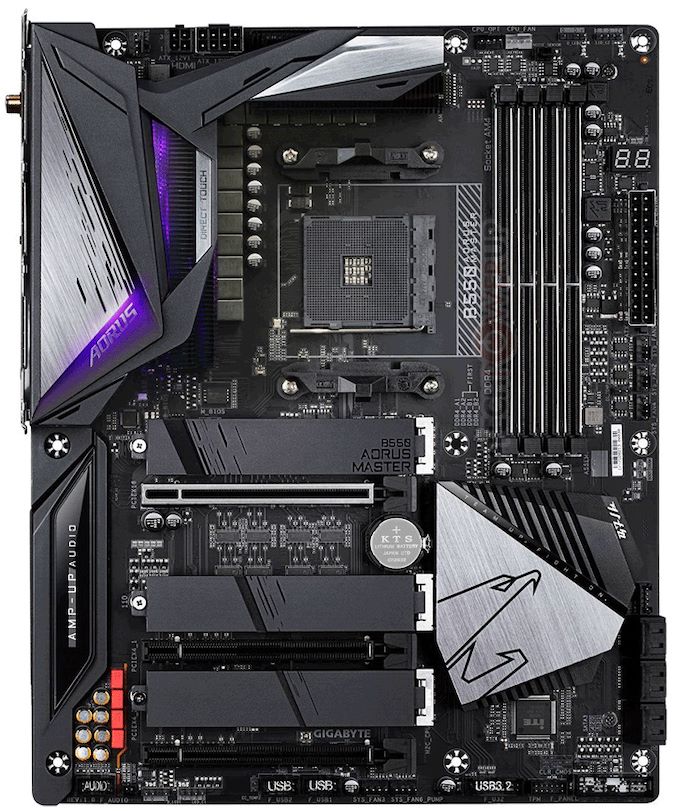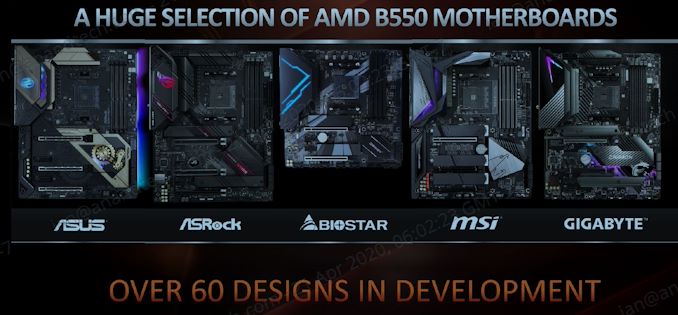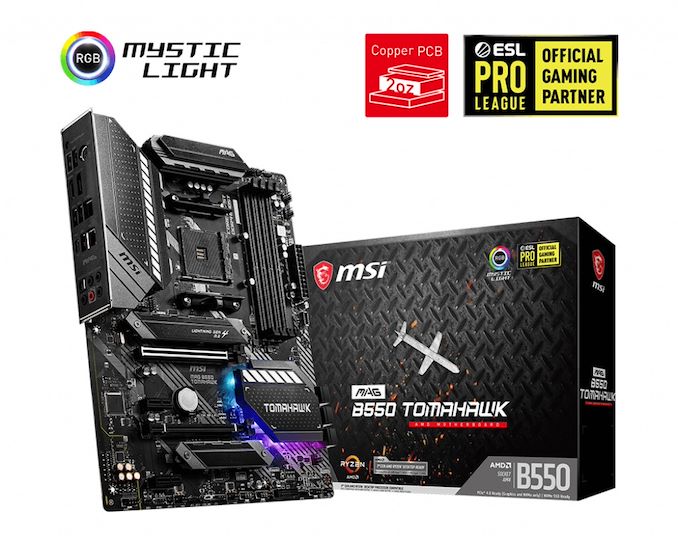AMD's B550 Motherboards Start Appearing Online
by Gavin Bonshor on May 21, 2020 1:00 PM EST_678x452.jpg)
Today is the next stage of the AMD AM4 B550 motherboard rollout: numerous vendors have started listing its models in place of an expected launch on June 16th. One big feature of B550 that B450 didn't have in the specifications was PCIe 4.0 support, and so this will be a big uplift with the new motherboards. Vendors today are unveiling the more price conscious models when directly compared to the premium X570 models.
The B550 chipset has been touted for many months, with much speculation on feature set, compatibility, and which AMD Ryzen processors users will opt to go for when pairing up a new board. One prevalent issue which AMD has addressed recently is that its impending Zen 3 and Ryzen 4000 processors will now be supported on B450 and X470, albeit without the benefits of PCIe 4.0 and its increased bandwidth. With this in mind, one of the main advantages of the new B550 chipset is that it will openly support PCIe 4.0 and Zen 3, which gives users more affordable options when it comes to selecting a new PC, whether it is a budget gaming system or an AMD Ryzen 3950X 16-core laden powerhouse.
AMD recently announced its Ryzen 3 3000 series processors, the Ryzen 3 3300X and Ryzen 3 3100 which we reviewed. Users looking to buy a new motherboard for AMD's more affordable Ryzen 5 and Ryzen 3 processors may not want to spend the big bucks some vendors are asking for some of its X570 models. Enter B550, and with over 50 models across all the prominent vendors to choose from, it's likely a user will be able to find one that not only matches their style requirements but matches what they need from a feature set as well.
| AMD X570, B550 and B450 Chipset Comparison | |||
| Feature | X570 | B550 | B450 |
| PCIe Interface from CPU | 4.0 | 4.0 | 3.0 |
| PCIe Interface from Chipset | 4.0 | 3.0 | 2.0 |
| Max PCH PCIe Lanes | 24 | 24 | 24 |
| USB 3.1 Gen2 | 8 | 2 | 0 |
| Max USB 3.1 (Gen2/Gen1) | 8/4 | 2/6 | 0/6 |
| DDR4 Support | 3200 | ? | 2667 |
| Max SATA Ports | 8 | 6 | 6 |
| PCIe GPU Config | x16 x8/x8 x8/x8+x8* |
x16 x8/x8 x16/+x4 |
x16 x16/+x4 |
| Memory Channels (Dual) | 2/2 | 2/2 | 2/2 |
| Integrated 802.11ac Wi-Fi MAC | N | N | N |
| Chipset TDP | 11W | ?W | 4.8W |
| Overclocking Support | Y | Y | Y |
| XFR2/PB2 Support | Y | Y | Y |
The biggest benefit going to B550 from B450 is official support for PCIe 4.0 devices within the full-length PCIe slot which is driven by the processor. This means that the top full-length slot will run at PCIe 4.0 x16, with some models allowing for x8/x8 from a second full-length slot with official support for NVIDIA SLI. From the CPU support pages that we've seen announced from vendors, B550 will only be compatible with AMD's Ryzen 3000 series processors. For users looking to use PCIe 4.0 storage devices, B550 models include a single PCIe 4.0 x4 M.2 slot, with any additional M.2 slots coming via PCIe 3.0 lanes from within the chipset itself.
Another benefit is the B550 chipset includes support for up to two USB 3.1 G2 ports which B450 didn't offer. B550 also retains the same capability in regards to USB 3.1 G1 support as B450 with up to six ports available from the chipset. Users can also install up to six SATA ports from the chipset, with the onus on vendors if they want to use additional re-drivers or SATA controllers to push the numbers further at the cost of PCH lanes. Some models leverage Realtek's ALC1220 on the more premium B550 models, with the ALC1200 featured on MSI's MAG B550 Tomahawk.

The GIGABYTE B550 Aorus Master motherboard
Motherboard vendors across the world have been enabling their public listings of the B550 product stacks online, with some notable models from GIGABYTE which include the B550 Aorus Pro AC which provides for one PCIe 4.0 x4 M.2 slot, an additional PCIe 3.0 x4 slot which is driven from the chipset and includes an Intel Wi-Fi 3168 wireless interface which is Wi-Fi 5 standard. ASUS has also announced its stack with the top model, the ROG Strix B550-E Gaming offering an Intel I225-V 2.5 G Ethernet controller, with three full-length slots offering x16, and x8/x8 for NVIDIA SLI multi-graphics configurations, with the third full-length slot operating at PCIe 3.0 x4.
MSI has also dropped its B550 stack publically, with the popular Tomahawk series appearing via the B550 Tomahawk has also been announced with support for up to DDR4-4866 memory, a full-length PCIe 4.0 x16 slot with a secondary full-length PCIe 3.0 x4 slot, with two PCIe 3.0 x1 slots. Users looking for small form factor models will find at least three mini-ITX models, with the most prominent model coming from ASUS via the ROG Strix B550-I with Intel's I225-V 2.5 G Ethernet onboard. There are also plenty of micro-ATX models with five from ASUS alone expected at launch, although some models may be region dependent.
In regards to the pricing on AMD's B550 models, only ASUS so far has announced any pricing, with prices starting at $134 for the ASUS Prime B550M-A, all the way up to $279 for the ASUS ROG Strix B550-E Gaming which has an Intel's AX200 Wi-Fi 6 wireless interface, an Intel I225-V 2.5 G Ethernet controller, and a SupremeFX S1220A HD audio codec. We expect more pricing to be available in the coming days and weeks.












50 Comments
View All Comments
azfacea - Friday, May 22, 2020 - link
thank you AMD for bringing 2.5 G ethernet and pcie 4 into sub 200 motherboard range.And go fuck yourself intel.
liquid_c - Friday, May 22, 2020 - link
You’re immensely dumb. You’re paying extra for something you’re not even using, at the moment. Do you have 2.5 G ethernet at home? Or how many components using pcie 4 are you using? Are you that blind as to not observe the slow but steady price increase of AMD’s boards? God damn it, some people will accept a tree up their ass as long as it from their favourite brand.Zoolook - Friday, May 22, 2020 - link
Do you realize that the 2.5G nic has nothing to do with AMD, that it's a choice made by ASUS?And that it's an intel nic? Which is good, it's one of their remaining strenghts.
azfacea - Friday, May 22, 2020 - link
do u realize that more often than not its realtek not intel NIC in amd mobos. and not by accident, one of intel's popular NIC relied on a MAC inside the intel chipset, and intel sold the standalone NIC at a premium. And that the intel 2.5G client NIC came out a full year after realtek brought one out for the masses. Gee i wonder why.do u also realize that choices made by ASUS such as 2.5 G or backward compatibility all seem to be dramatically different when its AMD mobos vs intel mobos ?? hmmm i never knew ASUS was part of a conspiracy to undercut intel.
of course in the middle of all this excess realization you failed to realize my comment was pcie4 as well and not just 2.5G Ethernet.
If all you wanted to do was to shil for intel and point out that intel has always had much greater market share in networking, you just made intel look a lot worse not better.
Spunjji - Friday, May 22, 2020 - link
I think the guy you're ranting at here was replying to liquid_c, not you..!abufrejoval - Friday, June 5, 2020 - link
I have NBase-T switches in my home lab & family network, with 10Gbit NICs where I have enough PCIe lanes to fit them, 2.5GBit USB 3 adapters where not (laptops, mostly). Most of the traffic is East-West to clustered SSD and RAID storage, not North towards the Internet, which doesn't reach 1Gbit/s yet. 1 vs 10Gbit makes a difference, when you keep your backup storage powered off between backups (helps with ransomware).10Gbit NIC cost is below €100, 2.5Gbit USB3 sells below €50, NBase-T ports are around €50/port on my desktop class unnoticeable noise switches from Buffalo and Netgear.
A single PCIe 4 lane would be enough to offer 10Gbit Ethernet, but AFAIK there are no NICs nor onboard options yet. Most current chipsets take 4 lanes of PCIe 2 for 10Gbit or 8 lanes for dual.
Not everybody has the same requirements as you. It doesn't make them dumb.
Operandi - Friday, May 22, 2020 - link
Are there any higher-end mATX options this round? ASRock probably had the best option in the Steel Legend but it wasn't particularly great.I don't need or want a behemoth ATX case and board with a sole (graphics) card and a bunch of dead space. ATX is a dumb waste of space and iTX is too limiting...
johnp_ - Saturday, May 23, 2020 - link
$2.40https://ark.intel.com/content/www/us/en/ark/produc...
Ghostline91 - Sunday, May 24, 2020 - link
How are the performance on these boards? Would also like to see the boards from biostar and asrock too.Omnomme - Monday, June 1, 2020 - link
I'm building a mini-ITX pc. The only real difference between the x570 and b550 are the max sata cables and max usb ports. Since mini-ITX already has to improvise and cut down on the amount of ports and PCIE slots, there really isn't a real difference between the x570 and b550 on this form factor. The upcoming release of these boards is just going to be another shipment of x570 boards for maybe a lower price.